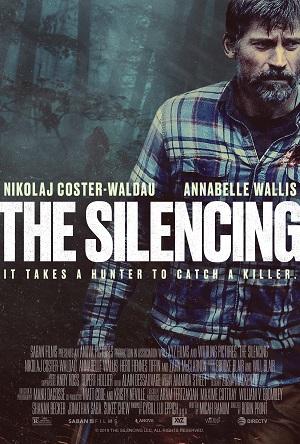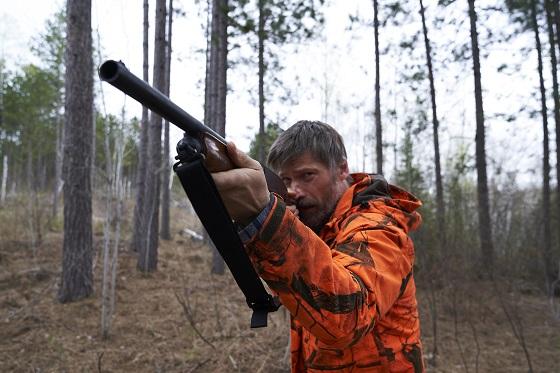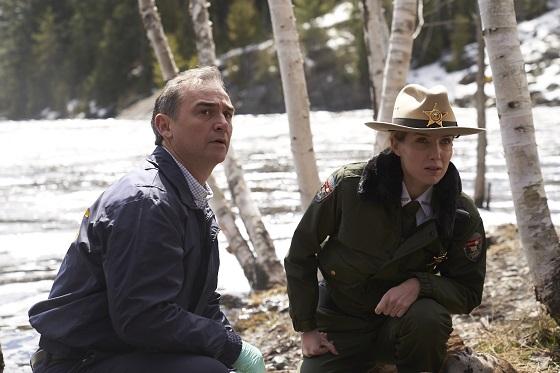

[Rating: Rock Fist Way Down]
Opening in theaters and on VOD and Digital on August 14.
Alfred Hitchock once said, “There is no terror in the bang, only the anticipation of it.” The Silencing is the new film by director Robin Pront, and while it has bangs to spare, there’s desperately little anticipation to be found throughout its 90-minute runtime. And while this particular film critic has long championed the resurrection of the hunt-humans-for-sport genre, this effort is such a misshapen, pedantic mess that it may well sink the fledgling genre for good.
At the root of the problems surrounding The Silencing is the competing leads, neither of whom are particularly well developed, and exist more as tropes than as fully formed characters. There’s the newly elected sheriff, Gustafson (Annabelle Wallis), who somehow got elected to her post despite the animosity of everyone in town and a sketchy brother, Brooks (Hero Fiennes Tiffin), everyone thinks is a criminal. The other part of this two-headed beast is Rayburn (Nikolaj Coster-Waldau), a reformed hunter and messy drunk who manages a wildlife preserve in the middle of the forest when he’s not making trips into town to hang “Missing” posters for his daughter now five years gone.
When a young woman’s body washes up on shore near Rayburn’s preserve, the sheriff and the drunk meet briefly to discuss the case and its potential connection to Rayburn’s daughter, and for a good while, this is the only thing bridging these two narratives. Which…actually…no, no: what’s at the heart of this film’s problem isn’t the leads but the construction of the plot, which is little more than a series of dead-ends that turn into new leads which are themselves dead ends which result in other leads that also fall flat until the final clue just sorta drops in the heroes’ laps. Early in the picture, when Sheriff Gustafson arrives at the murder scene her deputies discovered, a cop hovers over the deceased girl and asks, “Do you think whoever killed her was hunting her for sport?” The film just assumes this will be everyone’s first takeaway, which seems weird at first, yet less so later on when the script just starts throwing developments at Rayburn and Gustafson instead of leading the audience to them.

There’s nothing organic about this story, with clues leading to new ones that play like a shitty game of telephone with none of the fun of garbled transmissions. Gustafson follows a clue from the crime scene to the guy running the local hunting shop, who refers her to a black market weapon manufacturer, who leads her to another weapons maker who doesn’t talk, yet has a daughter who will, and sends her to another location. It’s no better for Rayburn, who just happens upon the murderer hunting a young girl at one point via his CCTV set-up, which leads to a mystery truck, which is the wrong truck, but it happens to lead him to the correct truck. It’s a connect-the-dots narrative without any world-building or character investment, for while Gustafson and Rayburn do have somewhat interesting backstories, nothing about them makes the pair essential to the eventual outcome (or each other).
Indeed, it could have been any two people in these situations: things would have ended up just about the same. What’s worse, this could have taken place pretty much anywhere, and The Silencing proves this by never establishing the “where” of all this. Come to think of it, what REALLY sinks The Silencing isn’t the characterization or plotting, but its utter failure to establish a sense of place for the setting, or any relative distance between the points most frequently visited (Rayburn’s cabin, the wildlife preserve, the town, the mystery barn, etc). Gustafson does run into some trouble at one point when the jurisdiction of her murder investigation leads to conflict with a local Native American tribe and their cop, Blackhawk (Zahn McClarnon), but where these borders start and stop, and how that relates to Rayburn’s nature preserve and the nearby town is never established.
Huh…when one takes a step back to look at it all, between the poorly sketched characters, pedestrian plotting, and the inability to establish any real setting, this movie is just flat-out bad. The story is little more than one long series of reveals with little in the way of suspense propping it up, and even less character to allow for an investment in it all. There is one legitimate “oh shit” moment about halfway through the film, yet it doesn’t fundamentally alter the course of the story despite the fact that it should change EVERYTHING about what’s going on. No, it serves as just one more breadcrumb that the script must dutifully follow before the big mystery is unboxed for the audience.

Visually, Pront uses her camera to inform some sense of character awareness, using shoulder-mounted shots for the outdoor bits, and more static camera work for Gustafson’s investigating. There’s a push and pull in this regard between the savagery of the wilderness and the relative calm of the civilized world, yet the script betrays this attempt at measured nuance. All kinds of bad stuff happens in town along with the human hunting in the forest, so this visual distinction doesn’t scan all that well as an artistic choice, and like the good performances of Coster-Waldau and McClarnon, largely goes wasted.
A suspense thriller desperately short on suspense, The Silencing feels less like a fully formed movie and more like the first cut of a film based on a script that was itself a first draft. The story just barely holds together via a series of clues that are the definition of telling instead of showing, leading to a final reveal that makes desperately little sense when one takes a hard look at the killer and their supposed motivation. If terror lies in the suspense and not the bang as Mr. Hitchcock suggested, The Silencing should have leaned into its eponymous moniker and less on the noise it lazily scatters about.





Comments on this entry are closed.